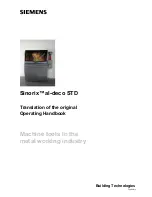
2
ENGLISH
!
IMPORTANT SAFETY INSTRUCTIONS
WARNING:
When using electrical equipment such as this, basic safety
precautions should always be followed to reduce the risk of personal injury.
Please familiarize yourself with the following information to prevent damage to
your equipment and injury to the operator, property damage, or death.
READ ALL INSTRUCTIONS BEFORE USING THIS
PRODUCT
We strongly recommend that this tool not be modified and / or used for any
application other than that for which it was designed. If you have any questions
relative to its application, do not use the equipment until you have consulted us and
we have advised you.
KEEP WORK AREA CLEAN.
Cluttered areas invite injuries.
CONSIDER WORK AREA ENVIRONMENT.
Don’t use power tools in damp,
wet, or poorly lit locations. Don’t expose your tool to rain. Keep the work area
well lit. Don’t use tools in the presence of flammable gases or liquids.
KEEP CHILDREN AND BYSTANDERS AWAY.
All children should be kept
away from the work area. Don’t let them handle machines, tools or extension
cords. Visitors can be a distraction and are difficult to protect from injury.
GROUNDED TOOLS
must be plugged into an outlet that itself is properly
installed and grounded. Grounding provides a low-resistance path to carry
electricity to ground away from the operator, should the tool malfunction
electrically. Do not remove the grounding prong from the plug or alter the plug
in any way. If in doubt as to whether the outlet is properly grounded according
to code, check with a qualified electrician.
OBSERVE PROPER PRECAUTIONS REGARDING DOUBLE INSULATION.
This tool is double insulated. It is equipped with a polarized plug. One blade
is wider than the other, so it will fit into a polarized outlet only one way. If you
have difficulty inserting the plug, try reversing it. If it still doesn’t fit, do not alter
the plug; have a qualified electrician install a polarized outlet.
GUARD AGAINST ELECTRIC SHOCK.
Prevent body contact with grounded
surfaces: pipes, radiators, ranges, and refrigerator enclosures. When your
body is grounded, the risk of electric shock increases. When working wherever
“live” electrical wires may be encountered, try to ascertain whether there is
a danger of shock. Even so, DO NOT TOUCH ANY METAL PARTS OF THE
TOOL while using it. Hold the tool only by the plastic grip to prevent electric
shock if you contact a live wire.
DO NOT ABUSE THE CORD.
Never carry your sander by the cord or pull
on the cord to unplug it. Protect the cord from potential sources of damage:
heat, oil & solvents, sharp edges, or moving parts. Replace damaged cords
immediately.
WHEN WORKING OUTDOORS, USE AN OUTDOOR-RATED EXTENSION
CORD.
An extension cord rated for outdoor use must be marked “W-A” or “W”.
DO NOT EXPOSE ELECTRICAL POWER TOOLS TO MOISTURE.
Rain or
wet conditions can cause water to enter the tool and lead to electric shock.
ENSURE THE EXTENSION CORD YOU USE IS OF SUFFICIENT GAUGE
FOR ITS LENGTH.
1.
2.
3.
4.
5.
6.
7.
8.
9.
10.
Recommended Minimum Wire Gauge for Extension Cords
Amps
from Tool
Nameplate
7.62 m
(25')
long
15.24 m
(50')
long
22.86 m
(75')
long
30.48 m
(100')
long
45.72 m
(150')
long
60.96 m
(200')
long
0 - 5 amps
16 ga. 16 ga. 16 ga.
14 ga.
12 ga.
12 ga.
5.1 - 8 amps
16 ga. 16 ga. 14 ga.
12 ga.
10 ga.
Do Not Use
8.1 - 12 amps
14 ga. 14 ga. 12 ga.
10 ga.
Do Not Use Do Not Use
12.1 - 15 amps
12 ga. 12 ga. 10 ga.
10 ga.
Do Not Use Do Not Use
15.1 - 20 amps
10 ga. 10 ga. 10 ga.
Do Not Use Do Not Use Do Not Use
Содержание SPT105
Страница 8: ...ENGLISH FRAN AIS SCHEMATIC DRAWING SCH MA...

































